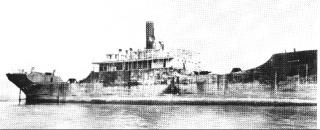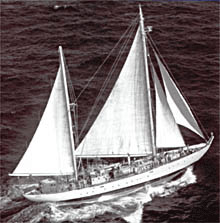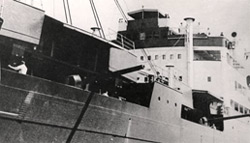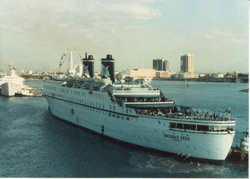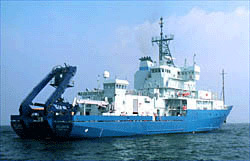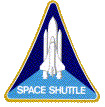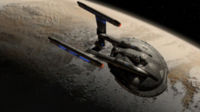Atlantis, Previous Vessels Named
Template:Atlantis-nav While the history of vessels named "Atlantis" may not be as prestigious as the history other vessels (such as "Enterprise"), it does maintain a certain air of interest and uniqueness. The name appears only as far back as the beginning of the 20th century. Any records of the name being used prior to this, though there is a high possibility, have yet to be discovered.
The first vessel on record to carry the name Atlantis was a wooden-hulled motorboat built in 1911 for civilian recreational purposes at Greenport, Long Island, N.Y., and was acquired by the United States Navy on 2 July 1917. She was renamed USS Atlantis (SP-40) and patrolled the Great Lakes region and multiple naval districts around New York State during World War I. Atlantis was decommissioned on 7 May 1919, removed from the Navy list on 7 July, and sold back into the civilian sector on 30 October 1919.
The second Atlantis was one of a dozen freighters commissioned by the United States (ca. 1919) to be built out of concrete. Concrete, a mixture of sand and gravel bonded together with a cement to form a solid heavy mass similar to stone, seems an unlikely substance to be used in aquatic vessel construction. As strange as it seems, a ship of concrete will float as long as the weight of water it displaces is more than its own weight. It is a matter of density. The ships were 76.2 meters long with a draft of 6.7 meters and a beam of 13.7 meters. The walls of the hull were 15 centimeters thick. They required only one-third of the steel necessary for a regular freighter. Some of them were used to transport troops back from Europe at the end of World War I. Soon after the war, when steel was more abundant, the concrete ships quickly became too expensive to operate. In 1926 the Atlantis was bought to be used as part of a dock on a proposed ferry line. A storm hit the region, breaking the ship loose and grounded her off of Sunset Beach, Cape May, NJ. She remains there to this day.
In unexpected anticipation of what her namesake was to embody, the next Atlantis was a research vessel; a 44 meter, steel-hulled, ketch-rigged ship that sailed over 315,000 kilometers for ocean science from 1931 to 1966. She belonged to the Woods Hole Oceanographic Institution (WHOI), and was the first ship built specifically for interdisciplinary research in marine biology, marine geology and physical oceanography. In 1966 she was sold to Argentina and her name was changed to El Austral. She was 43.7 meters long, with a draft of 5.5 meters and a beam of 8.8 meters.
The distinguished name of Atlantis was to be tarnished, however, during the Second World War. Atlantis, known to the German navy as Schiff 16 and to the British Royal Navy as Raider-C, was a converted German Hilfskreuzer (auxiliary cruiser, or merchant or commerce raider) of the German navy, which, during World War II, traveled more than 161,000 km in 602 days, and sank 22 ships totaling 144,384 tons. Such commerce raiders did not usually engage other warships, but rather sought to sink enemy shipping, similar to the work done by submarines. This ship was 155m long and displaced 7,862 tons. She had a single funnel amidships. She had a crew of 349 (21 officers and 328 enlisted troops) and a Scottish terrier, Ferry, as a mascot. The cruiser carried a dummy funnel, variable-height masts, and was well supplied with paint, canvas, and materials for further altering her appearance, including costumes for the crew and flags. Schiff 16 was capable of being modified to 26 different silhouettes. Although she was launched in 1939, ice blocked her way until early 1940. She masqueraded as various Soviet, Japanese, Dutch, and British vessels. During her missions she once captured copy of Broadcasting for Allied Merchant Ships, which contained communications codes, and another time a cargo ship carrying 15 bags of mail. This mail included the whole of the Top Secret mail for the High Command, Far East, new code tables, and a War Cabinet report on British forces, defenses of Singapore, information regarding Australia and New Zealand, and an appraisal of Japanese intentions. A copy was given to the Japanese and it is sometimes argued that this played a prominent part in the Japanese decision to initiate what it referred to as the, "Greater East Asia War". Atlantis was finally caught and sunk on November 21, 1941 by the HMS Devonshire.
The Federal Shipbuilding & Dry Dock Co. of Kearny, NJ, USA built a vessel in 1944 named the General R.M. Blatchford. By August it had been launched as a U.S. Navy troop ship under the name General W.P. Richardson. It was transferred to the U.S. Army in 1946, and laid up in March 1948. In 1949 it was purchased and converted to a passenger liner, the Laguardia. She returned to troop service during the Korean War, then was purchased by another cruise line and renamed the Leilani in 1957. She was repurchased again in 1961, renamed the President Roosevelt, then repurchased again in 1970 and renamed Atlantis. Atlantis sailed as a passenger liner from June 1971 to October 1972. Her route was between New York and the Bahamas. After 1972 she was repurchased and renamed several more times, each time by a different cruise line for different routes.
The Atlantis II, the successor of the WHOI's original research vessel, was constructed in 1963 to continue Atlantis' work. Atlantis II concluded 34 years of service, over 450,000 kilometer sailed for science, and more than 8,000 days at sea, a record unequaled by any research vessel. In 1996 she was delivered to Shaula Navigation, based in Boulder CO for rechristening as Antares and a planned new career as a fisheries research vessel in the North Pacific and Gulf of Alaska. She was 64 meters long, with a draft of 5.2 meters and a beam of 13.4 meters.
Atlantis replaced the Atlantis II and was named for WHOI's original research vessel. She made her first call in homeport on April 1997. The new Atlantis had advanced support facilities to service and launch submersibles, such as Alvin, and a wide variety of ROVs at locations throughout the global oceans. She was one of the most sophisticated research vessels afloat, equipped with precision navigation, bottom mapping, and satellite communications systems. Atlantis was owned by the US Navy and operated by the Woods Hole Oceanographic Institution in support of the US academic ocean research community. She was 83.5 meters long, with a draft of 5.2 meters and a beam of 16 meters.
The primary space agency for the United States, NASA, began developing reusable space vehicles in the 1970s. The fourth one, named Atlantis in honour of the original WHOI research vessel, was commissioned to be built in 1979 and completed in 1984. Its maiden voyage took place in late 1985, on October 3. Also known as Space Shuttle Orbiters, or simply space shuttles, the orbiters were wide-body, delta-winged airplane and space vehicles. Atlantis was constructed primarily out of aluminum and covered with reusable surface insulation. It was propelled by 49 rocket engines employed in various combinations for liftoff, attitude control in space, and for initiating reentry. Utilizing the 18.3 x 4.57 m cargo bay, its primary missions were ones of payload delivery to Low Earth Orbit, satellite retrieval/in situ repair, short-duration science platform, and Space Station assembly/servicing. The forward section of the orbiter contained the flight deck and crew quarters for the astronauts. Located at the aft end of the crew quarters deck was an air lock through which astronauts could enter the cargo bay when extravehicular activities were necessary. Varying mission profiles called for crews of between 2 and 8 people, and durations up to 16-day, or 28-days with Extended Duration Orbiters (EDO) kits. Its wingspan was 23.79 m, and it had a length of 37.24 m, height of 17.27 m, habitable volume of 71.5 m3, and a dry mass of 78,687 kg.
Atlantis, NX-05, was commissioned in 2163, and was a member of the Earth Starfleet's NX-class starships. She survived 4 separate 3-year missions; her first 3 being captained by Captain Ti'jon, and the last by Captain Woodard. During her first 3-year mission, Atlantis managed to catalogue and completely survey 6 different star systems, including 37 different planets (6 Class M), 4 gaseous anomalies, and made first contact with the Alvanians. Her second 3-year mission was less eventful, having Atlantis see an engine refit to the new warp-7 capable engines for the last 8 months. Captain Ti'jon's last 3-year mission was thankfully uneventful, as the Atlantis was assigned border patrol with known Xindi space. Captain Woodard managed to finagle Starfleet into returning Atlantis to exploration duties, and 4 more star systems were thoroughly catalogued and surveyed. Having served for just over 12 years, Atlantis was far from being obsolete, but significant enough progress had been made technologically that major refits still would not have brought her up to par with the rest of the fleet. Atlantis was reassigned as a cadet training vessel at Starfleet Academy in 2176. She served there faithfully for the next 8 years before being decommissioned.

